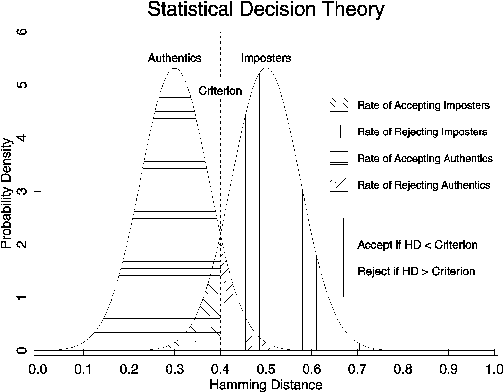Next: Strategies and Decidability Up: Statistical Decision Theory Previous: Statistical Decision Theory
![]()
![]()
![]()
Next: Strategies and Decidability Up: Statistical Decision Theory Previous: Statistical Decision Theory
Yes/No recognition decisions have four possible outcomes: either a given pattern is, or is not, a true instance of the category in question; and in either case, the decision made by the algorithm may be either the correct one or the incorrect one. In the present application the four possible outcomes are termed Acceptance of Authentic (AA), Acceptance of Imposter (IA), Rejection of Authentic (AR), and Rejection of Imposter (IR). Obviously the first and fourth outcomes are desired, and the second and third outcomes are errors. The goal of the decision-making algorithm is to maximize the conditional probabilities of AA and IR, while minimizing the likelihoods of IA and AR. The pairwise trade-offs among the probabilities of these four outcomes can be manipulated in a way that reflects their associated costs and benefits in a particular application.

Figure 7: Statistical Decision Theory: formalism for decisions under uncertainty.
The Neyman-Pearson formalism for decision problems in which the prior probabilities are not known and the error costs are not fixed, but the posterior distributions are known, is summarized in Figure 7. A given measurement of the Hamming distance between two iris codes constitutes a point on the abscissa. This measurement is regarded as being a sample from one of two random processes (``Authentics" or ``Imposters"), whose probability distributions have been arbitrarily shown here as Gaussians with large overlap for purposes of illustration. The two distributions PAu(x) , and PIm(x), specify respectively the probability density of a particular measured Hamming distance, x, arising from two comparisons of the same iris, or from two comparisons of different irises. Any measured Hamming distance smaller than a chosen decision criterion, as indicated by the dotted line in Figure 7, is judged to belong to the Authentics distribution, while any Hamming distance greater than this criterion is judged to belong to the Imposters distribution. The probabilities of the four possible outcomes AA, IA, AR, and IR are equal to the areas under the two probability density functions PAu(x) and PIm(x), on either side of the chosen decision criterion C:
These four probabilities are represented by the four shaded areas in Figure 7.
![]()
![]()
![]()
Next: Strategies and Decidability Up: Statistical Decision Theory Previous: Statistical Decision Theory